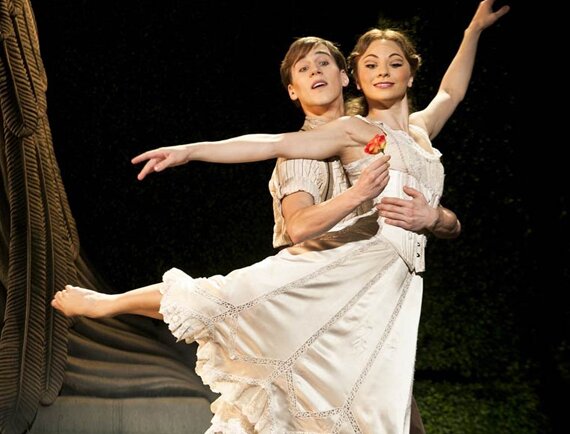Since its creation 25 years ago, Matthew Bourne’s renowned dance company, New Adventures, has performed some of ballet’s most famous works; none more famous than those by Tchaikovsky. First came Bourne’s take on The Nutcracker, in 1992, followed by his 1995 production of an all-male Swan Lake, which went on to become an international hit. Now, finally, completing the trio of Tchaikovsky’s works is Bourne’s interpretation of Sleeping Beauty. Premiering at London’s Sadler’s Wells Theatre at the end of 2012, the production has now come full circle, ending its UK tour with a week of performances at Sheffield’s Lyceum Theatre. Remodelled as “a Gothic romance”, Bourne’s take on this much-loved classic is not your traditional fairytale, and as such, is absolutely exceptional.
This production is split into four different time periods. 1890, which shows Aurora as a baby and follows the more traditional feel of classical ballet. 1911, when Aurora comes of age, where the Waltz was still prominent, but this period also introduces “new dance crazes” from America, such as “the maxixe”. The action then moves forward 100 years, to 2011, where Aurora finally awakens, and the finally period – “Last Night”, which sees Aurora about to be wed, takes on the feel of a cult ritual rather than that of a fairytale wedding!
The story does, for the most part, follow that of the traditional ballet – a King and Queen (Edwin Ray and Daisy May Kemp, respectively) despair at their inability to conceive a child and so, they ask the dark fairy, Carabosse (Malificent in Disney’s version) to bless them with one, which she does. However, the King and Queen forget to show their gratitude toward Carabosse (Adam Maskall), and she plots a terrible revenge. However, this is where the story begins to differ. Carabosse instead dies alone and broken in exile, where it falls to her loyal son (also Maskall), Caradoc, to carry out the wicked deed. As Aurora (Hannah Vassallo) comes of age, we see that she has fallen in love with Leo, the Royal Gamekeeper (Dominic North), who, upon learning of Aurora’s curse, is turned into a vampire by Count Lilac, the King of the Fairies (Liam Mower), in order to be around to awaken Aurora once 100 years have passed. Now, whilst this could have come across as a ridiculous, it is instead used a vital plot point in order to propel the story along, and works incredibly well.
The entire company are absolutely exceptional, performing with electrifying energy that draws you in instantly. Vassallo’s Aurora is perfectly portrayed; girlishly beguiling, a young, spirited wild child, tamed only by North’s Leo. Their blossoming relationship is captivating to watch, tenderly playful, full of childish humour and full of passion. It is Mower’s Count Lilac, and Maskall’s Caradoc, however, that are the standout performances. Mower’s performance is, quite simply, electrifying, and it is the ambiguity of this character, the notion of whether he is truly light or dark – is what is so fascinating. Maskall’s portrayal of the vengeful Caradoc is truly unnerving – particularly when we first see him during Aurora’s birthday celebrations, enticing her to take the dark rose he holds out to her, and as he sits watching over her as she sleeps.
The scenery, costumes and music are, of course, absolutely stunning – the ornate setting of Aurora’s childhood home is beautifully crafted, and the costumes of the fairies during Act One are utterly gorgeous, creating a truly magical sense of grandeur. However, it is in fact the little things, the incredible attention to detail, that makes this performance so wonderful. The baby Aurora, portrayed by a puppet and worked by several hidden puppeteers a la War Horse, is an absolute joy to watch in the show’s opening scenes, bringing a realism to a puppet of a human child that I’ve never seen before onstage. The act of having the characters of Aurora and Leo in flesh-coloured masks during the sequence where Aurora’s parents learn from the King of the Fairies the fate of their daughter is another wonderful touch. Also the careful attention to the use of the music within the production; for example, a piano is only heard within the show’s score once the action has entered the time period where the piano has been invented. This adds a layer of detail unlike any other production I’ve seen. Also the use of projected words across a screen at the beginning and throughout; opening with the famous words, “Once upon a time…” in old-fashioned, Gothic text, as the time periods move on, the text projected onstage begins to change, becoming more and more modern, finally finishing in Comic Sans. A wonderfully minimal touch that adds so much authenticity. This change towards the contemporary is also noted in the dancing itself, as well the costumes, never ignoring the fact that with the changing years, the dancing itself must change.
This production of Sleeping Beauty is unlike anything ever seen before onstage. The new additions to the narrative works exceptionally well, never once feeling unnecessary – in fact, they almost feel as if they’ve always been there! The entire company is fantastic, bringing the magic of Tchaikovsky’s music alive on stage with infectious enthusiasm. Bourne weaves his spell with such genuine passion that it would take a heart as hard as Carabosse’s not to be swept up in the enchanting beauty and loveliness of this fairytale. An absolute must-see.
Matthew Bourne’s Sleeping Beauty is at Sheffield’s Lyceum Theatre until Saturday 25th May 2013. Visit www.sheffieldtheatres.co.uk for tickets and other details.
Words: Katy Roberts.




